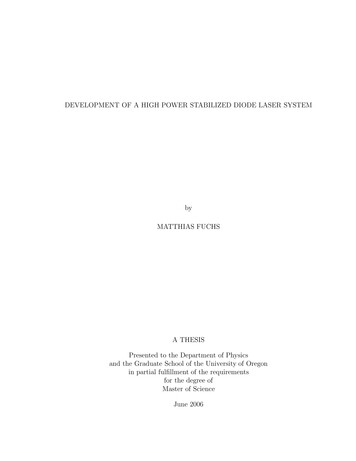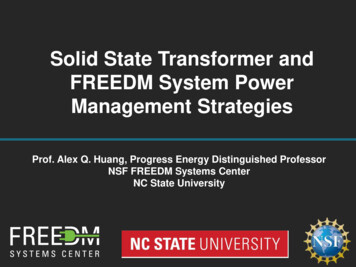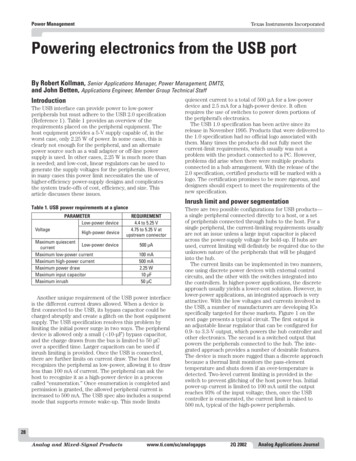
Transcription
DEVELOPMENT OF A HIGH POWER STABILIZED DIODE LASER SYSTEMbyMATTHIAS FUCHSA THESISPresented to the Department of Physicsand the Graduate School of the University of Oregonin partial fulfillment of the requirementsfor the degree ofMaster of ScienceJune 2006
ii“DEVELOPMENT OF A HIGH POWER STABILIZED DIODE LASER SYSTEM,”a thesis prepared by Matthias Fuchs in partial fulfillment of the requirements for theMaster of Science degree in the Department of Physics. This thesis has been approvedand accepted by:Professor Daniel Steck, Chair of the Examining CommitteeDateCommittee in charge:Professor Daniel Steck, ChairProfessor Michael RaymerProfessor Stehphen GregoryAccepted by:Vice Provost and Dean of the Graduate School
DEVELOPMENT OF A HIGH POWER STABILIZED DIODE LASER SYSTEMCopyright June 2006byMatthias Fuchs
ivAn Abstract of the Thesis ofMatthias Fuchsfor the degree ofin the Department of PhysicsTitle:Master of Scienceto be takenJune 2006DEVELOPMENT OF A HIGH POWER STABILIZED DIODELASER SYSTEMApproved:Professor Daniel SteckThis thesis describes the design and realization of a high power diode laser system.The system consists of a single mode external cavity diode laser (ECDL) which isinjection locked into a free running laser diode. The beam of this low power masterslave configuration is coupled into a high power tapered amplifier diode. The goalof the laser system is to provide a dipole trap for ultra-cold Rubidium atoms. Theoutput power of the system is 1 W.
vDEDICATIONThis is for my parents and for Matthias Baar, who left us long before his time.
viACKNOWLEDGEMENTSWithout all the help of my collegues and friends, I could never have successfullyfinished the task that I’m describing in this thesis.First of all I want to thank my adviser Dan Steck. He was always there whenI needed advice, whether it was on theoretical concepts, experimental procedures orjust a good idea to put drain pipe cleaner on food. He always took time to explain andto discuss physics problems. He invented the long, long tradition of the weekly Fridayice cream, which definetly contributed to the relaxed atmosphere in the lab. I alsowant to thank my lab mates for helping me and providing a fun working environment.Tao Li was a great help to me in explaining some optics setup procedures. It wasalways fun and interesting to talk with him about Chinese culture and sports.Libby Schoene added a female note to the lab and just by her presence madebeing in the lab a nicer experience. I always enjoyed discussing both physics andnon-physics related subjects with her.It was also a pleasure to bug Aaron Webster by any means possible. He is just theman to have weird conversations with and to tell funny stories. Jeremy Thorn alwaysreminded me when it was “cookie time”. He helped me greatly in writing a programthat fetches data from the voltmeter. Otherwise, my measurements would have takenabout a Zillion years. Jeremy and Aaron were also responsible for introducing me tosome very instructive short movies about the Martians from Sesame Street.
viiFinally, I cannot forget Peter Gaskell who was always very helpful when I hadproblems with electronics or computers.Overall, there is a very good working atmosphere in the Steck lab that made meget up every morning and willingly go to work. I am very confident that this lab andof course the people working in it have much potential and eventful, successful andbright futures.Without the people working in the machine shop I could also never have builtsuch a device. Kris, John and Jeff showed me how a lathe and a milling machinework, and even managed to teach me how to machine precise parts. They were all abig help when I needed suggestions on how to machine . . . basically anything.I also want to thank Emelie. Without her, I probably would never have startedthis project. I want to thank her for all her love and all the wonderful time that wecould spend together. She was there for me every day and helped me through thedark days full of frustation, but she was also there to share my joy. The walks withher often helped me to get my thoughts off of problems and to rejuvinate my mindand eventually solve the problems with fresh ideas. She is constant source of joy. Herendless will to bug me and her sense of humor infinitly brightened up my life.Of course, I also want to thank my parents, my brother, and my friends back inGermany. Although we were spatially very far separated, we were very close in spirit.It is not an easy step to leave one’s home to live in a foreign country, but all myfriends and family supported me and helped me with my decision.
viiiAnd then I came to the US . . . and made more friends. They all helped me tohave a good time here and even made me stay longer than I originally planned. I candefinitely conclude that these two years in the US were among the best years of mylive.
ixCURRICULUM VITANAME OF AUTHOR: Matthias FuchsPLACE OF BIRTH: Ellwangen, GermanyDATE OF BIRTH: August 6, 1980GRADUATE AND UNDERGRADUATE SCHOOLS ATTENDED:University of OregonUniversität Stuttgart, GermanyDEGREES AWARDED:Master of Science in Physics, 2006, University of OregonVordiplom in physics, 2003 Universität Stuttgart
xTABLE OF CONTENTSChapterPageI. INTRODUCTION . . . . . . . . . . . . . . . . . . . . . . . . . . . . . .1I.1. Dipole Trap . . . . . . . . . . . . . . . . . . . . . . . . . . . . . .I.2. Quantum-Mechanical Description . . . . . . . . . . . . . . . . . .23II. THEORY OF THE LASER . . . . . . . . . . . . . . . . . . . . . . . . 11131419262830III. THE EXPERIMENTAL SETUP . . . . . . . . . . . . . . . . . . . . . .III.9.III.10.III.11.Interaction of Photons and Atoms . . . . . . . . .Rate Equation . . . . . . . . . . . . . . . . . . . .Elements of a Laser . . . . . . . . . . . . . . . . .The Principle of a Laser . . . . . . . . . . . . . . .The Diode Laser . . . . . . . . . . . . . . . . . . .Absorption and Emission Revisited . . . . . . . . .TE & TM Polarization . . . . . . . . . . . . . . .Current, Temperature and Frequency DependenceThe Tapered Amplifier . . . . . . . . . . . . . . . .The “Lasers” s . . . . . . . . . . . . . . . . . . . .Pseudo-External-Cavity Laser or the “Master” . .Frequency Stabilizing the Master Laser . . . . . .Slave Laser . . . . . . . . . . . . . . . . . . . . . .Optical Setup I . . . . . . . . . . . . . . . . . . . .Injection Locking the Master to the Slave Laser . .Injecting the Slave Laser in the Tapered AmplifierOptical Setup II . . . . . . . . . . . . . . . . . . .Handling of the Tapered Amplifier . . . . . . . . .Design Considerations for the Housing of the TA .The Temperature Encounter . . . . . . . . . . . .3637384142434647495054IV. Results . . . . . . . . . . . . . . . . . . . . . . . . . . . . . . . . . . . .57IV.1. Amplified Spontaneous Emisssion . . . . . . . . . . . . . . . . . .57
xiIV.2.IV.3.IV.4.IV.5.Amplification of the Seed Beam . .Spectrum . . . . . . . . . . . . . .Optimizing the Output of the TA .Spatial Profile . . . . . . . . . . .59616263V. Conclusions . . . . . . . . . . . . . . . . . . . . . . . . . . . . . . . . . .68APPENDIX . . . . . . . . . . . . . . . . . . . . . . . . . . . . . . . . . . . . .69A. Technical Drawings . . . . . . . . . . . . . . . . . . . . . . . . . . . . . .70BIBLIOGRAPHY . . . . . . . . . . . . . . . . . . . . . . . . . . . . . . . . .72
xiiList of FiguresFigurePageI.1 Blue (left) and red detuned (right) Gaussian laser beam that repel andattract atoms, respectively. . . . . . . . . . . . . . . . . . . . . . . . . .3II.1 Gain curve of a laser with the modes of the resonator. . . . . . . . . . . 15II.2 p-n junction with an external potential U. . . . . . . . . . . . . . . . . . 18II.3 Cut through a p-i-n heterostructure energy diagram, size of electrons andholes not to scale. . . . . . . . . . . . . . . . . . . . . . . . . . . . . . . . 20II.4 One dimensional energy diagram for electrons and holes. Ec is the energyof the conduction band, Ev the energy of the valence band. An electroncombines with a hole and a photon of energy ω is emitted. . . . . . . . 21II.5 Radiative transitions in semiconductors: a.) spontaneous emission, b.)stimulated emission and c.) stimulated absorption. . . . . . . . . . . . . 22II.6 Energy diagram of a multi-quantum well surrounded by a confinementstructure. . . . . . . . . . . . . . . . . . . . . . . . . . . . . . . . . . . . 27II.7 The peak emission wavelength of a diode laser. The dashed line representsthe change of the peak gain and the solid line the changes of the cavitylength and the refractive index. After [3]. . . . . . . . . . . . . . . . . . 29II.8 Schematic drawing of a tapered amplifier. . . . . . . . . . . . . . . . . . 30II.9 Far-field intensity pattern of a tapered amplifier. . . . . . . . . . . . . . 34II.10 Picture of the tapered amplifier compared to a match. The golden coloredpart is the c-mount of the diode. The real diode is the small blue dot ontop of the mount. It appears to be blue in this picture but it is black inreality. . . . . . . . . . . . . . . . . . . . . . . . . . . . . . . . . . . . . . 35III.1 Picture of the optical setup. . . . . . . . . . . . . . . . . . . . . . . . . . 36III.2 Picture of the master laser. The path of the laser beam is indicated bythe red line. . . . . . . . . . . . . . . . . . . . . . . . . . . . . . . . . . . 37III.3 Picture of the Slave Laser. . . . . . . . . . . . . . . . . . . . . . . . . . . 41III.4 Schematic of the optical setup. . . . . . . . . . . . . . . . . . . . . . . . 42III.5 Tapered amplifier with the out-coupling optics to compensate for the astigmatism. . . . . . . . . . . . . . . . . . . . . . . . . . . . . . . . . . . . . 48III.6 Sideview of the tapered amplifier housing. . . . . . . . . . . . . . . . . . 51III.7 Picture of the tapered amplifier housing. . . . . . . . . . . . . . . . . . . 53III.8 Schematic of the protection circuit. The diodes prevent the TA fromforward and backward transients, the ferrit bead and the capacitors forma low-pass filter. The ferrite beads (1 ) are Panasonic EXC-ELSA 35. . . 54III.9 Schematic drawing of the tapered amplifier housing. . . . . . . . . . . . 55
xiiiIV.1 Horizontal beam profile of the amplified spontaneous emission at a currentof IT A 0.75A, after the collimation and the cylindrical lens. . . . . . .IV.2 Horizontal beam profile of the amplified spontaneous emission at a currentof IT A 0.75A, after the collimation and the cylindrical lens. . . . . . .IV.3 Low resolution ASE spectrum at ITA 1.5A and 17.5 C. . . . . . . . .IV.4 Power of the input laser versus the amplified power for two amplifier currents: 1600 mA and 2000 mA. . . . . . . . . . . . . . . . . . . . . . . . .IV.5 Temperature dependence of the output power versus the driving current.IV.6 Output power versus current for two different seed powers of 8 mW and13 mW. . . . . . . . . . . . . . . . . . . . . . . . . . . . . . . . . . . . .IV.7 Spectrum of the TA for a output power of 0.5 W. The solid curve isoptimized for the most absolute power, the dashed curve for the mostpower at 780 nm. The inlet shows the difference between both graphs.Note: the inlet has a linear y-axis. . . . . . . . . . . . . . . . . . . . . .IV.8 Horizontal profile for a seeding laser power of Pseed 8 mW and anamplifier power of PT A 100 mW. . . . . . . . . . . . . . . . . . . . . .IV.9 Vertical profile for a seeding laser power of Pseed 8 mW and an amplifierpower of PTA 100 mW. . . . . . . . . . . . . . . . . . . . . . . . . . .IV.10Horizontal profile of the TA for the same input power of 8 mW and anoutput power of the tapered amplifer of 100 mW and 400 mW. . . . . .IV.11Vertical profile of the TA for the same input power of 8 mW and an outputpower of the tapered amplifer of 100 mW and 400 mW. . . . . . . . . .IV.12Horizontal beam profile for different input powers at the same outputpower of 100 mW. . . . . . . . . . . . . . . . . . . . . . . . . . . . . . .IV.13Vertical beam profile for different input powers at the same output powerof 100 mW. . . . . . . . . . . . . . . . . . . . . . . . . . . . . . . . . . .V.1 Picture of the tapered amplifier, emitting to the left, with the two collimation lenses. . . . . . . . . . . . . . . . . . . . . . . . . . . . . . . . . .A.1 Drawing of the large copper block (A). . . . . . . . . . . . . . . . . . . .A.2 Drawing of the baseplate with water-cooling ability. . . . . . . . . . . . .57585960606162646565666767687071
1CHAPTER IINTRODUCTIONIn recent years, semiconductor diode lasers have shown improved reliability, power,and wavelength coverage. With the ability to provide more power, diode lasers cannow compete with heavy and bulky gas and other solid-state lasers. They have becomeincreasingly common in industrial applications, since they are compact, easy to cool,and have a power efficiency upwards of 50%. Another advantage of diode lasers isthat they can have a very high spatial beam quality, and their frequency can be veryeasily and rapidly tuned by changing the injection current. Furthermore, with thedevelopment of the semiconductor industry, they have also become less expensive.Concerning the work in science, diode lasers have become one of the workhorsesfor atomic physics. In order to confine ultra-cold rubidium atoms in a dipole trap,powerful lasers with a wavelength in the vicinity of 780 nm are often used. Atoms arescattered out of a dipole trap at a rate of Γsc I/ 2 with I being the intensity ofthe laser beam and the detuning of the beam frequency from the atomic transition.Therefore a far detuning is needed. However, since the potential of the trap has adependence of U I/ , a high intensity beam is also necessary.
2I.1. Dipole TrapFirst, a brief overview of the dipole trap is given. For a more in-depth description,refer to [1].The dipole trap confines neutral atoms using the interaction of light with an atom.Light is nothing more than an electromagnetic field that exerts a force on an electricdipole moment. Since rubidium is a neutral atom, it possesses in the ground stateno permanent electric dipole moment. But the field of a laser induces a shift on theenergy states of an atom. This shift, known as the AC Stark shift or light shift, is achange of potential energy of the atom. Therefore, if the potential is lowered by theinteraction with the light and the electromagnetic field of the laser is inhomogeneous(has a gradient), the atom moves to the place with the lowest potential, which is thespot with the highest field. Since the induced shift is not static but oscillatory, thefrequency of the laser light also has to be taken into account. If the light is belowthe atomic resonance (red detuned), the energy of the ground state and thereforethe potential is lowered, resulting in an attractive force towards the highest intensityof the field. On the other hand, if the light frequency is higher than the resonancefrequency (blue detuned), the ground state is raised, which means that the atom isrepelled by high intensities. This behavior can be understood by using the classicalLorentz model of an atom. In this model the atom consists of a very heavy core(compared to the electron) and an electron which is bound to the core via a spring
3FIGURE I.1: Blue (left) and red detuned (right) Gaussian laser beam that repel andattract atoms, respectively.representing the electromagnetic force. If this system is now driven by an externaloscillator (the optical field) with a frequency below the resonance frequency, thesystem can “keep up” and stays in phase with the light field thus drawing the atominto the region where the oscillator is the strongest. If the oscillator frequency exceedsthe resonance, the system can no longer follow and becomes out of phase, so that thedipole moment opposes the light field and the atom is repelled by high intensities.I.2. Quantum-Mechanical DescriptionA quantum-mechanical formulation is now presented to give an overview of themathematical description of the dipole trap.The so-called “dressed-atom picture” describes the coupling of a two-level atom
4with a light field. The Hamilton operator of such a system is the following:Ĥ ĤA ĤL V̂AL .(I.1)Here, ĤA is the Hamiltonian of the two level system with a ground state gi andexcited state ei, separated by an energy of ωA ,ĤA ωA ei he ,(I.2)and ĤL is the Hamiltonian of the light field. For simplification, only a monochromatic field with a frequency ωL is considered. By using the creation and annihilationoperators for photons, aˆ† and â respectively, the operator reads as follows:ĤL ωL ↠â.(I.3)The eigenstates of these two operators are “Fock states” and are represented by g, ni and e, ni, where n is the number of photons in that state. Next, some wellknown approximations for the laser field are applied that simplify the calculationsenormously. First, for optical frequencies, the variation of the electromagnetic fieldof the laser on the order of the atom size can be neglected, and the atom can beapproximated as a dipole. Then, the interaction term V̂AL isV̂AL d̂ · Ê.(I.4)Here d̂ er̂ is the atomic dipole moment operator and Ê is the electric field operatorof the laser light.
5The second approximation, known as the rotating wave approximation (RWA),assumes ωL ωA ωL ωA and neglects the fast oscillating term (see [2]). For aplane wave with an amplitude E0 , the interaction term at a certain spatial position(choose z 0) becomesV̂AL where Ω : eE0 Ω iωLt(âe ei hg â†e iωL t ei hg ),2(I.5)he r gi is the Rabi frequency. A transformation to a rotating framegets rid of the phase factors and the Hamiltonian becomes, using L ωL ωA , LĤ Ω2The eigenvalues of this Hamiltonian are:Ee,g Ω20 . L p 2 L Ω2 22(I.6)(I.7)In the limit of far detuning, L Ω, the energy shift can be expanded to first orderin Ω/ L , yielding: Ω24 L Ω2. Ee 4 L Eg (I.8)(I.9)This is the Stark shift that induces the dipole moment, drawing the ground state atominto high intensities for red detuning ( L 0) and repelling it from high intensitiesfor blue detuning ( L 0).
6If an electrical field in the z direction is considered, the force acting on an atom isF * V̂AL z ,(I.10)since this is the relevant term of the Hamiltonian that describes the interaction. Theresult of this equation is [1] sF 1 s 1 Lqr γqi2 (I.11)where s I/[Is (1 (2 L /γ))] is the saturation parameter, Is πhcγ/(3λ3 ) is thesaturation intensity, γ is the decay rate of the spontaneous emission and qr iqi isthe logarithmic derivative of the complex function Ω. It is defined asddzln[Ω(z)] (qr iqi). For a travelling electro-magnetic wave, E E0(ei(kz wt) cc.), the positiondependence is only in the phase and therefore qr 0 and qi k. For a standingwave, E E0 cos(kz)(e iwt cc.), qr k tan(kz) and qi 0.It can be seen that there are essentially two different forces acting on the atom.The first is the spontaneous scattering force, which acts in the direction of laserpropagationFsp kγI.2Is 1 I/Is (2 L /γ)2(I.12)It is related to the scattering rate Γsc in the following way:Fsp k · Γsc .(I.13)The other force is the optical dipole force, which acts in the direction of the laser
7intensity gradient,Fdip 2 k sin 2kzI L.Is1 4I/Is cos2 kz (2 L /γ)2(I.14)By taking a closer look at Eqs. (I.12) and (I.14), it can be seen why the laser fora dipole trap should be very powerful: The further the detuning L of the laser,the smaller the scattering rate, because it is proportional to I/ 2L . Since the dipolepotential is just proportional to I/ L, a deep dipole trap can still be achieved byusing high laser intensities.
8CHAPTER IITHEORY OF THE LASERII.1. Interaction of Photons and AtomsFor the purpose of clarity and simplicity, we consider the most basic interactionbetween photons and atoms that make up a laser. Therefore, we restrict ourselvesto a two-level system. For example, this could be an atom that has two states 1iand 2i corresponding to discrete energy levels E1 and E2, respectively. All the otherstates are neglected. Furthermore, we consider only monochromatic light, so that allthe interacting photons have the same frequency and therefore the same energy.If the electromagnetic field of a light beam is coupled to this atom, three differenttypes of interaction can take place.A. Spontaneous EmissionIf the system is initially in the upper state 2i, the electron can drop spontaneouslyinto the lower state 1i. By doing that, the atom emits a photon of energyEph hν Ewhere E E2 E1 .(II.1)
9This emission is random in direction, phase, and time, with the result that theemitted light is incoherent.The transition rate of this process is: dn2dt γn2 ,(II.2)spont. em.where n2 is the population density of the state 2i, γ is a the decay rate and the minussign comes from the fact that n2 is decreasing.B. AbsorptionAbsorption occurs if a photon with resonance energy E interacts with a systemthat is in the state 1i. The energy of the photon is absorbed with a certain probability,and the system is raised into the upper state.Since absorption depends on the light field as well as the population density n1 ofstate 1i, one can write the transition rate as: dn1dt B12u(ν)n1 ,(II.3)18πhn3ν 3hν3cexp( kB T 1)(II.4)stim. abs.withu(ν) being the spectral energy density written in terms of Planck’s black-body radiationformula of the stimulating photon field, B12 being the proportionality constant, andthe minus sign again indicating the decreasing of n1 .
10C. Stimulated EmissionThe final interaction is the inverse process of absorption. It is again an emission,but this time it is stimulated, meaning that the system is in the upper state whena photon with the resonance frequency interacts with it. The photon stimulates thesystem to drop into the lower state and emit another photon in the same mode asthe interacting photon. This means that the emitted photon has exactly the samefrequency, phase, direction of propagation, and polarization as the stimulating photon.This process can be used to amplify an optical beam because it is a coherent radiation.Light sources that produce light in this way are called LASERs (Light Amplificationby Stimulated Emission of Radiation). Many atoms in state 2i are needed to get areasonable amplification of the initial interacting light field. An ensemble of atomshaving a greater population density in the upper state than the lower state is called“population inversion”.Again, the transition rate depends on the spectral energy density u(ν) and thepopulation density n2, dn2dt B21u(ν)n2 ,(II.5)stim. em.with B21 being a proportionality constant.II.2. Rate EquationTo describe the whole two-level system now, we must combine the three processes.
11To this end, we follow the simple argument of Einstein who considered an ensemble ofatoms in thermal equilibrium in the presence of a light field of spectral energy densityu(ν).Transitions from state 2i to state 1i comprise both spontaneous and stimulatedemission, so the total transition rate r21 isr21 γn2 B21u(ν)n2(II.6)where γ and B21 are the Einstein coefficients of spontaneous and stimulated emission,respectively.The transition rate from the lower to the upper state is only comprised of absorption,r12 B12 u(ν)n1(II.7)with B12 being the Einstein coefficient for stimulated absorption.In thermal equilibrium both rates are equal, so thatγn2 B21u(ν)n2 B12 u(ν)n1 .(II.8)Eq. (II.8) is known as the rate equation of a two level system. We will come back tothis equation later, when we will discuss it in the context of the diode laser.II.3. Elements of a LaserThe laser is essentially an optical oscillator. Parts of the output of this optical
12resonator are fed back with the correct phase into the input. In order to achieve this,a laser usually consists of three elements.The active medium is a medium with population inversion such that a light fieldpropagating through it will be amplified by stimulated emission.The pump delivers energy to the active medium so that there can be a populationinversion. The pump can consist of a flash lamp, gas discharge or another laser. Inthe case of a diode laser, the pump is very convenient, as it is just an electrical currentthat places charge carriers in the active medium so that population inversion can beachieved.Finally, an optical resonator is required. This is usually accomplished with aFabry-Perot-Interferometer (FPI). Due to the boundary conditions of a FPI, onlycertain modes that form a standing wave inside the cavity can be excited. Thecondition for a standing wave is:L mλ02neff(II.9)with λ0 being the vacuum wavelength, nef f the effective refractive index of the cavityand m 1, 2, 3, . . . .The resonator stores some of the radiation emitted by the active medium in a fewmodes so that the number of photons in these modes is n 1. This increases theprobability of stimulated versus spontaneous emission. The resonator is also recycling
13modes back into the active medium so that another cycle of stimulated emission isstarted by photons in the same mode and the laser light stays unaltered. The resultis a light oscillator rather than a light amplifier.For a semiconductor laser, the active layer also acts as the cavity. Using a coatingon the front and back facets, the required reflectivity can be achieved. Depending onthe index of refraction and the thickness of the layer, an antireflection coating canbe applied. The standard material for this is Al2O3 , which also has the advantageof being able to passivate and protect the extremely sensitive facets. By alternatinglayers of Al2O3 and Si, a so-called Bragg reflector with a high reflection coefficient canbe created. For high power diode lasers, the back facet is usually highly reflective,whereas the front facet is antireflection coated, so that the photon density insidethe cavity is reduced. This effectively eliminates destructive interference from backreflection of the front facet and results in an increased output power.II.4. The Principle of a LaserUsually the active medium is surrounded by the resonator. One of the resonator’swindows is partially transmitting so that the laser light can be extracted through it,but there is still enough reflection to maintain an oscillating wave in the resonator.Another crucial condition, of course, is that the pump provides enough power tocompensate for the emitted laser beam and other losses.If the active medium is in a state of population inversion, and the interacting
14optical field is strong enough to make stimulated emission the dominant process,then an incoming photon of the right frequency will produce another photon emittedin exactly the same mode. Now, both of those photons can stimulate two other atomsto emit photons in the same mode, etc. This means that one incoming photon canproduce an avalanche of photons in the same mode, and therefore the intensity of theelectromagnetic wave traveling in the z-direction grows exponentially, neglecting gainsaturation effects:I(ν, z) I(ν, 0)eα(ν)z .(II.10)When α(ν) 0, this is known as Beer’s law of absorption.Since the resonator only sustains frequencies that correspond to wavelengths forming a standing wave in the resonator, only a few modes of the continuous gain spectrum are selected (Fig. II.1). Furthermore, only the modes where the resonatorspectral line intersects the gain curve above threshold are amplified.II.5. The Diode LaserSemiconductorsDue to the overlap of the atomic orbitals in a semiconductor, the electrons aren’tlocated in discrete levels as in a single atom. Instead they form a continuous “bandstructure.” The band structure consists of a conduction and a valence band, separatedby an energy gap Eg , which is typically 0.5 - 2.5 eV. The conduction band is filled with
gain15thresholdwavelengthFIGURE II.1: Gain curve of a laser with the modes of the resonator.electrons and in an undoped material there are as many holes in the valence bandas electrons in the conduction band. Holes are “missing” electrons in the valenceband that can also move and therefore conduct current. Due to the continuousband structure, the electrons in the conduction band and the holes in the valenceband can move nearly freely and can thus be approximately described as an electrongas. Therefore, the electrons in thermal equilibrium in a semiconductor are Fermidistributed,f(E, T ) 1Fexp( E EkB T) 1,(II.11)where EF is the Fermi energy. For T 0 K, f becomes a step function with the valuef 1 for energies below the Fermi energy and f 0 above EF , which means that allelectrons are in the valence band.
16Doped SemiconductorsThe properties of a semiconductor (where the atoms forming a semiconductor arein group IV) can easily be changed by doping it with atoms of groups III and V. If asemiconductor is doped with atoms of group V (P, AS,.), just 4 of the outer electronsof the atom take part in the chemical bonding, and one electron is very weakly bondedto the atom. The result is that the 5th electron has a very low ionization energy ( 0.1 eV or smaller). These electrons sit on an energy level that is higher than theenergy of the conduction band and very close to the valence band. Therefore, theFermi energy of the so-called n-doped semiconductor rises to this level.For p-doping, one puts some atoms from group III (B, In,.), having just 3 outerelectrons in the semiconductor, and instead of electrons with energies close to theconduction ba
IV.1 Horizontal beam profile of the amplified spontaneous emission at a current of ITA 0.75A, after the collimation and the cylindrical lens. . . . . . . 57 IV.2 Horizontal beam profile of the amplified spontaneous emission at a current of ITA 0.75A, after the collimation and the cylindrical lens. . . . . . . 58











